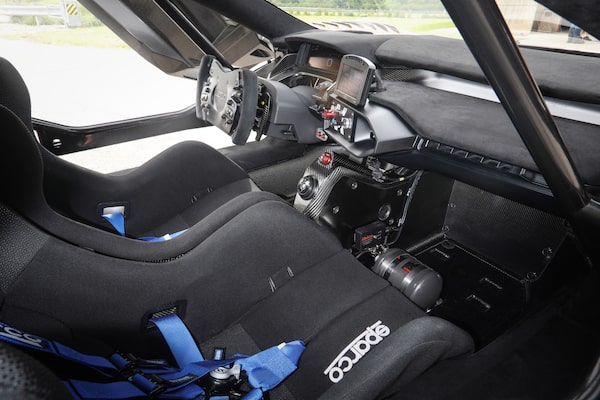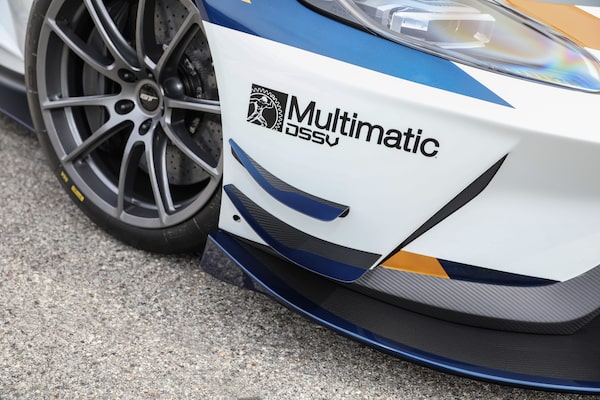
The Ford GT Mk II delivers the full performance potential of the Ford GT in a track-only version engineered independent of race series rules, regulations and limitations.FREERS PHOTOGRAPHY LLC
It’s safe to say that Larry Holt is not the biggest fan of the Balance of Performance approach to motorsport. Also known by its mildly-derogatory-sounding acronym, BoP, it’s a method of attempting to achieve a level playing field among racecars powered by a wide range of engineering solutions. At various points within a season, the authorities governing a race series may decide whether a car should be restricted or unleashed through various means, including methods that involve the amount of airflow into the engine or the amount of ballast a car carries. This is the act of balancing performance.
Holt is the chief technical officer for Multimatic Inc., the Markham, Ont.–based outfit that builds the Ford GT and its racing derivative, the GTLM, in partnership with Ford Performance. Since the introduction of the race version in 2016 (the street-legal car would follow later that year), the GT has enjoyed great success on the track, including taking class victory at the 24 Hours of Le Mans. But the racing program has also endured some tough defeats and the BoP continues to be an agenda item in the debriefing sessions.
The introduction in early July of the Ford GT Mk II – an ultra-exclusive variant that sits in between the street-legal version and the racecar – is not a shot at the people responsible for the BoP. But it is a response. “The question has always hung in the air since the very beginning,” Holt says during a top-secret reveal at the Ford Dearborn Development Center on June 18. “ ‘What could you do if you did all the things we did with the racing car and then didn’t have these BoP limitations, these rules?’ This is the answer.”
The Ford GT Mk II shares countless common features with the road car and the GTLM, but it’s the differences that tell the story.

The 7-speed dual-clutch automatic transmission is from the Ford GT, but with changed ratios and boosted shift speed.FREERS PHOTOGRAPHY LLC
First things first: The GT Mk II is a track-only special edition with performance levels that will leave both the road car and the GTLM in the dust in most settings. The mid-mounted twin-turbocharged 3.5-litre V6 develops 700 horsepower, more than both the GTLM (about 495 hp) and the road car (650 hp). “Historically, you think, Oh, the racecar is a higher-performance version of the road car,” Holt explains. “That’s not the case. In fact, the racecar is sort of a lower-performance version, at least from a power perspective.”
Final torque figures have not been established because the GT Mk II has not received final sign-off yet. Holt and the representatives from Ford Performance also decline to make any claims as to acceleration times or top speed. “We’re not after that,” Holt notes. “We’re after lap time.” Nevertheless, everyone involved is confident that the GT Mk II will rocket past the 200-mph barrier.
While top speed for the car is not the primary concern, various steps have been taken to ensure that the GT Mk II will be quick out of the box – and will stay that way for hours and hours around the racetrack.
The 7-speed dual-clutch automatic transmission is from the Ford GT, but the ratios have been changed and shift speed has been boosted. In place of the active rear wing on the road car, there’s a massive fixed rear wing that generates 350 pounds greater downforce than the rear wing on the GTLM. To compensate for this increase and to reduce lift at the front of the car, louvres are set in the front fenders and a gigantic front splitter with flicks and dive planes has been added. The adaptive suspension system on the road car has changed as well. Although the suspension geometry is the same, the ride height is effectively fixed in track mode all the time, with a ride height that’s 5 mm above the GTLM car. The net result: The GT Mk II develops four times the downforce of the road car.

The Ford GT Mk II features carbon-ceramic brake rotors with revised calibration for the anti-lock braking system.FREERS PHOTOGRAPHY LLC
The GT Mk II also features the carbon-ceramic brake rotors from the road car, but with different brake pads and revised calibration for the anti-lock braking system. While the road car has 20-inch wheels and tires, the GT Mk II runs on 19-inch slick tires. On the inside, there’s a reworked interior with custom-designed Sparco race seats, new carbon-fibre trim pieces and a Motec data acquisition system. With all the changes, the car is expected to be only 100 kg heavier than the GTLM car.
Two weeks after the unveiling, the Ford GT Mk II made its dynamic debut at the 2019 Goodwood Festival of Speed in the United Kingdom. In his first appearance at the event, driver Scott Maxwell won the supercar shootout, setting the fastest time on the 1.86-km hillclimb course. The Canadian was pitted against some of the very best supercars in the world and was doubly challenged by having to use treaded tires that had not been tested previously. People took notice.
As one might expect, the Ford GT Mk II will be available in strictly limited numbers. Only 44 will be built and this number will be taken out of the allocation of 1,350 allotted for the Ford GT road car. The track special will cost in the area of US$1.2-million, but this could be considered a bargain compared to the immediate competition. For the money, there’s also plenty of room for customization, according to Holt. “At this level, when a guy wants to buy a car like this and he asks for something … [if he] wants a carbon cupholder, well, I guess we’ll do a carbon cupholder.”
The writer was a guest of the automaker. Content was not subject to approval.
Shopping for a new car? Check out the new Globe Drive Build and Price Tool to see the latest discounts, rebates and rates on new cars, trucks and SUVs. Click here to get your price.
Stay on top of all our Drive stories. We have a Drive newsletter covering car reviews, innovative new cars and the ups and downs of everyday driving. Sign up today.